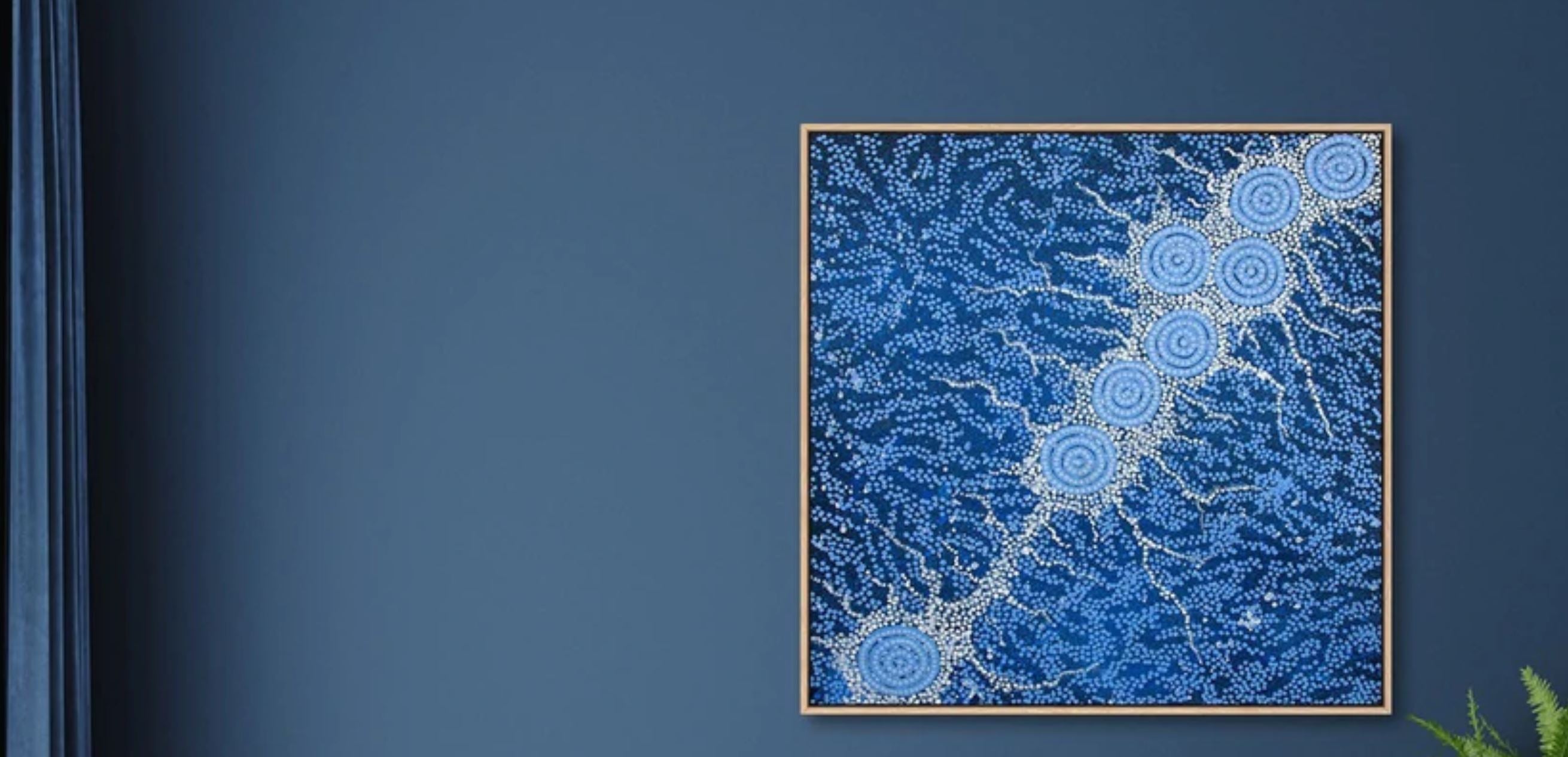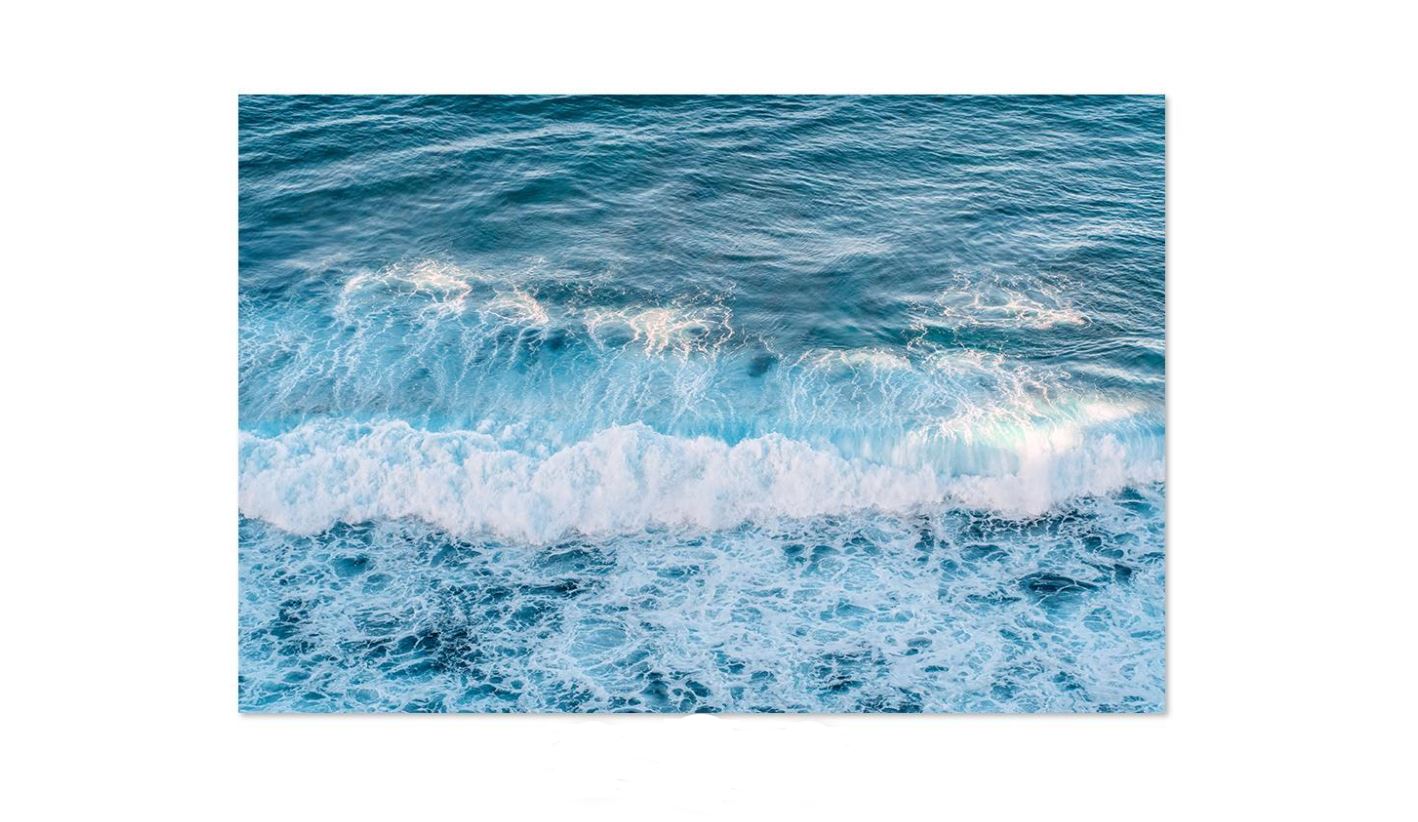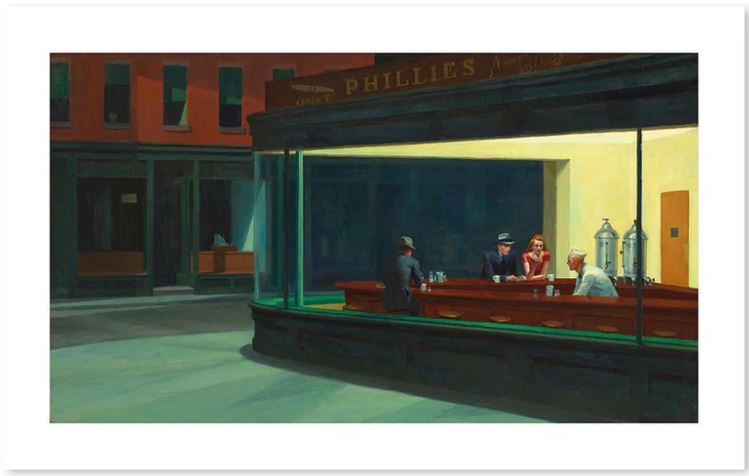
The History and Meaning Behind Aboriginal Dot Painting Art
An aboriginal painting is much more than what you see.
While colourful patterns come together with symbols to create one story on the surface, behind this story lies several layers, each depicting another level of the story, and these stories can only be understood and interpreted by the initiated. This one of the many reasons why aboriginal art is so revered and celebrated.
These days, indigenous artworks can sell for thousands if not millions of dollars, however, the contemporary aboriginal art movement that we know today really only began around half a century ago. So, how did one of the world’s oldest art forms become what it is today?
Well, we’re going to give you a bit of overview of indigenous art, the history of it, as well as the way symbolism is used throughout it, so settle in and enjoy the ride.

Woman's Dream Wall Art Print by Michelle Possum Nungurrayi
Australia Aboriginal Art History
Aboriginal art is considered by critics as the oldest art form, with it potentially dating back as far as 80,000 years.
Art is so central to the aboriginal lifestyle as there is no written language for the Australian Aboriginal people. So, the way to tell stories and pass on information of cultural significance was through symbols, icons, and patterns, which from an outside perspective, appear as art.
The information passed on through these symbols and icons is a very important way that the aboriginal culture is preserved.
However, while many stories and events have been told through these pieces, one of the most interesting aspects of the aboriginal culture is that for an artist to depict a traditional story or a sacred teaching in their art, they must ask for permission to do so from the elders of their community before they start.
The importance of an indigenous person’s clan and community is significant. Not only does it influence the stories that are and can be told, but also influences the way in which they are told. Certain styles, symbols and even colours used in indigenous art can be attributed to certain regions and communities.
Indigenous Australian art has been depicted in a variety of ways, including cave paintings, bark paintings, and as body paint. It’s only been since the 1970s, that aboriginal artists have been creating their art on canvases.
Understanding the Aboriginal Art Australian
As we touched on earlier, the significance of community is reflected in the works of an aboriginal artists – with their work often being identified as being from a specific community rather than attributed to an individual artist.
While western artists tend to have their unique style and design and depict any story at any time, an indigenous artist aims to be telling the story of their people and community through the style of their community. While artists will have their own technical and expressive flair to their work, it’s not always possible to distinguish between the different artists’ works. But it’s this tie to their community that is so important and having that distinction of the artist over the community is not a priority for aboriginal artists.
When we look at an aboriginal painting, there may be some symbols and icons that we can draw meaning from and interpret a story. We might also be able to appreciate other traditional western art concepts such as the abstract, minimalist or expressions nature of the piece. However, there is also a spiritual element that ties back to a story of significance that you’re likely to never fully understand.

Many indigenous artworks are also told from an aerial perspective, with the symbols and icons representing various things, such as people, watering holes, meeting places, animals, and sacred sites. Because of the aerial perspective, the symbols used are not necessarily an obvious icon but may tie back to the item they are representing in another way. For example, many animals are depicted by their footprints rather than from an aerial view of the animal itself. These symbols can be common from community to community, though the way in which they are used will depend on the patterns, colours, and history of the community.
One way to think of aboriginal art and the story being depicted in a piece is that there are layers that are designed to allow various people to view, interpret and understand the art. While arguably all art incorporates different meanings, tells different stories, and can be interpreted in various ways, many artists will be open about their thoughts, feelings, and ways to interpret their pieces.
However, with indigenous art, there is truly sacred meaning behind each piece, so the layers are carefully designed to depict these stories and allow for the multiple levels of interpretation and understanding. It allows their culture to be passed on from generation to generation while still keeping elements sacred.
Often the layers of an aboriginal painting will be called the outer layer and the inner layer, or the inside and outside layer.
The outer layers have some details that are more easily identified and allow casual observers to identify elements, symbols, and icons such as animals and people. Then within this imagery and amongst the patterns and background, the way all of these elements combine tend to tell another story – the inner layer story.
To fully understand this layer, you would need to be the artist, a senior community member or an elder. You need to be able to decode not only what the colours, patterns and designs used mean, but also the way in which they have been used in the past and how they are being used now.
These layers are important as they keep the hidden meaning and sacred secrets of a community intact while also allowing a form of expressionism that allows their story to live on.

Common Symbolism in Australian Aboriginal Art
Symbols are used throughout aboriginal art to help tell stories and convey themes and moods. Many of these symbols are used throughout indigenous artworks, however, while what they represent might have some commonalities from tribe to tribe, the way in which they are depicted, and the different styles of the specific tribe might mean that they have different meanings.
Some of the most common symbols used by various indigenous communities include:
People
The depiction of people in aboriginal art usually takes the form a U shape. This shape is chosen as it is the aerial view of someone sitting cross-legged on the ground. As we mentioned earlier, many indigenous works are from an aerial perspective. To symbolise whether the person is a male or female, the tools, or utensils beside them will represent this.
Given the importance of people in their stories, U shapes are common in many indigenous artworks.
Hunter
When a hunter is represented in indigenous art, often it will also be a U shape with a tool that indicates they are a hunter. This tool is usually shown as a line next to the U, representing a spear or other weapon.
In most instances, a hunter will be a male.
Emu
While the exact importance of the emu in aboriginal culture isn’t entirely known, it is very commonly depicted throughout indigenous works. This could be due to there being many of them around.
However, it has also been linked to creation stories, with a big emu in the sky present in some aboriginal stories.
It is most commonly depicted like an arrow, which represents its footprints.
Snake
The snake is a highly respected member of the animal kingdom in indigenous communities. It is a symbol of strength and survival. It can also be representative of the serpent of creation. As snakes are native to all parts of Australia, they feature heavily in indigenous art.
It can be connected to creation and power as the snake is known for being able to burrow into the earth and reappear somewhere else.
The snake is also a symbol of food, as well as being associated with water, as the Rainbow Snake, a powerful spirit could travel, live, and protect water locations all over the land.
Concentric Circles
Depicted as circles within circles, the concentric circle is a very common symbol throughout indigenous art. It is used to represent a variety of different things, including but not limited to:
- A specific significant site
- A meeting place
- A waterhole
When used to depict sites and meeting places, these are considered to be highly significant as this represented the coming together of people, and usually the discussion of important public matters.
When used to depict watering holes, this too help great importance as the waterhole is a symbol of survival, particularly in desert-based communities. A waterhole is seen as a sacred place and is often a meeting point.
Interpreting the meaning of a concentric circle often involves the use of other symbols that have been used around it which may indicate whether there are people meeting at a meeting place or water flowing from a waterhole for example.

Dreamtime and Aboriginal Art
Whether you’re new to indigenous art or culture or not, there is a chance that you will have heard of Dreamtime.
For aboriginal Australians, Dreamtime is of cultural significance as it represents the period when life and the world were created.
Many indigenous artworks can be tied back to Dreamtime, often depicting the landscape, animals, and the symbols of power and creation, such as the Rainbow Serpent.
Dreamtime is a common theme of aboriginal art and always will be.
Aboriginal Dot Paintings
Arguably the most well-known style of aboriginal art, dot paintings, like all other indigenous works, have many complicated layers and tell various stories depending on your ties and understanding of a community.
Dots are used in various ways in indigenous art, sometimes they are simply a background or a way to fill a space, but most commonly they have been used to hide or obscure symbols and therefore true meaning or story behind a piece.
Interestingly, the dot style is one of the most identifiable forms of indigenous art, yet it can hide the most meaning and completely change the story the symbols may be telling.
Dot paintings take indigenous artists literally hundreds of hours to complete. Every single dot, even used as a background or filler, is carefully thought out and executed.
Unlike the painting styles we might be most privy to, like those of traditional western artists, a traditional aboriginal artist doesn’t use an easel for their canvas. The canvas will be flat on the floor, and they too will be on the ground painting.

Australia Aboriginal Art Today
Did you know that aboriginal artists have only recently been using canvas to create their art since the 1970s?
The story is that Geoffrey Bardon, a schoolteacher who was working with Aboriginal Children near Alice Springs, noticed that Aboriginal men would draw symbols on the ground or sand as they were telling stories.
As he found this fascinating, he encouraged them to draw these symbols and stories on canvases and boards to be able to capture and preserve their work.
Over time, as indigenous artworks were starting to be exposed to other communities and people, the interest in indigenous art grew. People being interested in buying and displaying these pieces in homes and galleries throughout Australia.
These days people are paying significant amounts of money for aboriginal artwork – 2007 saw the first aboriginal artwork sell for over $1 million, and later that year a piece by Clifford Possum Tjapaltjarri sold for $2.4 million.
The amazing rise and recognition of this incredible art form are well deserved and an exciting movement for the aboriginal community of Australia.
Australia Aboriginal Paintings For Sale at Gioia Wall Art Online Shop
While buying an original aboriginal artwork might be out of the realm of possibility for you, if you want to introduce this style into your home, you can do so with some help from us here at Gioia.
We have a collection of indigenous wall art prints available for you to purchase in a variety of sizes and styles – many of which have been shown above throughout this piece. Our aboriginal art is available in many different patterns and colour palettes, so you’ll be able to find something that speaks to you and suits your style.
Many of our pieces are by the revered Possum Family, who are known as trailblazing contemporary aboriginal artists.
You can shop our aboriginal artworks online from anywhere in Australia, with Free Australia-wide shipping available for all orders.


